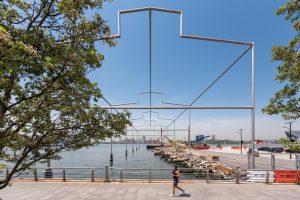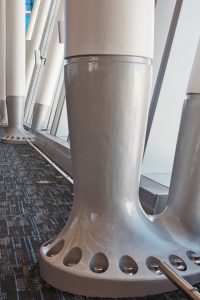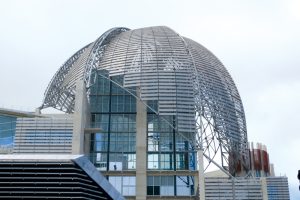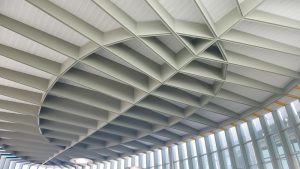Achieving AESS and AESSS Goals
When properly executed, the decision to expose structural steel offers a powerful opportunity to express a project’s tectonics and aesthetic goals. The 2016 American Institute of Steel Construction (AISC) Code of Standard Practice for Steel Bridges and Buildings (ANSI/AISC 303) introduced the architecturally exposed structural steel (AESS) category system, a systematic method of communicating craftsmanship quality to support goals for the final appearance of the finished structure. Prior to 2016, the lack of a categorized approach uniformly accepted by the Architecture-Engineering-Construction industry posed challenges in communication between the design and construction team, as well as with Owners. Today, when properly understood and leveraged, the Category system can support project outcomes that meet designers’ intent, are properly budgeted during the bid process, and achieve ultimate aesthetic goals for which fabrication quality is a foundation.
Still, even as designers have become more familiar with the category approach, additional questions have arisen about achieving AESS goals successfully; additional resources have been developed in response. This article provides an overview of guidance on best practices for designers considering AESS for their projects, including an outline of recently developed resources and tips on how to address frequently asked questions.

New Resources Available
Since 2016, new standards of care and guides by AISC and the American Galvanizers Association (AGA) have been developed to support AESS design:
- Code of Standard Practice for Steel Buildings and Bridges (AISC/ANSI 303-22) – the new COSP provides a few modifications to the standard of care for AESS that provides more clarity for the fabrication and erection of AESS.
- Code of Standard Practice for Structural Stainless Steel Buildings (AISC 313-21) – this new standard of care introduces a category system for architecturally exposed structural stainless steel (AESSS).
- Hot-Dip Galvanized Architecturally Exposed Structural Steel – Specifiers Guide (AGA 2021) – this new design guide helps designers achieve both low maintenance corrosion protection with the enhanced aesthetics for galvanized AESS.
In addition to industry publications, project teams are encouraged to discuss time and labor-saving best practices with structural steel and stainless steel fabricators. Architecturally Exposed Structural Steel: Specifications, Connections, Details by Terri Meyer Boake includes inspirational AESS projects from around the world, making it an excellent addition to any AESS library.
What is AESSS?
In 2021, Section 10 of the AISC Code of Standard Practice for Structural Stainless Steel defined the five categories for architecturally exposed structural stainless steel (AESSS). And similar to AESS, the AESSS categories are as follows:
AESSS 1: Basic elements.
AESSS 2: Feature elements viewed at a distance greater than 20 feet (6 m).
AESSS 3: Feature elements viewed at a distance less than 20 feet (6 m).
AESSS 4: Showcase elements with special surface and edge treatment beyond fabrication.
AESSS C: Custom elements with characteristics described in the contract documents.
While on the surface, the AESSS categories appear to mimic the AESS categories, designers should note that the fabrication, finishing, and erection requirements for AESSS vary greatly from AESS. Therefore, designers first exploring AESSS are encouraged to reach out to stainless steel fabricators and review Chapter 11, Fabrication and Erection, of the updated AISC Design Guide 27 – Structural Stainless Steel.
Best Practices for Contract Documents
It is vital to include thorough specification language and information on the project design drawings to properly communicate the desired level of craftsmanship and scope for exposed structural steel and structural stainless steel. AESS/AESSS is under the scope of the steel fabricator, and while creating their bids, the fabricator looks to the 051210 section for AESS/AESSS requirements. Standard specification language can be found on MasterSpec or other platforms – rather than including the entirety of the boilerplate specification for all categories, consider deleting categories not relevant to the project to help avoid confusion during the bid process.
The category type and extents of AESS/AESSS should be shown on the design drawings – at a minimum on the Structural Set as these are the documents that steel fabricators look to first to define AESS/AESSS scope. Therefore, be sure to clearly call out the Category and extent of said category on the drawings. Successful approaches to this may include extent lines on details with detail sheet notes; for complex projects, a shaded isometric drawing may be used to indicate AESS/AESSS extents. This is particularly helpful at transition points between AESS/AESSS categories and between AESS/AESSS and standard fabrication.
For larger projects, it is suggested that the design team conducts a kickoff meeting with the winning contractors to ascertain that the AESS/AESSS scope – including category types and extents – has been properly understood during the bid and award process and ensure that the requirements of AESS/AESSS Custom categories are adequately understood. This meeting is an opportunity to clarify to the Owner the budget implications of the initial AESS/AESSS scope and to allow the design and steel teams to move forward with necessary adjustments for the steel contract budget and scope in an informed and effective manner. In addition, the fabrication and erection schedule should be discussed when a mockup has been required for the project, as mockup fabrication and approval are part of the critical path. Consider the minimal extent of the mockup required to properly confirm the craftsmanship level to streamline this process.
Use of Steel Castings
The steel casting design and manufacturing process allows project teams to achieve freeform connections and shapes that may be difficult to accomplish with traditional fabrication methods. Advanced methods in finite element analysis, metallurgy, and manufacturing allow for creating large or small customized designs for signature projects with higher-level aesthetics and high structural performance (high wind, high seismic, fatigue, etc.). In addition, the casting supplier can work closely with the steel fabrication and erection teams to include fabrication and constructability features that can provide additional labor savings.
Project teams looking for pre-engineered off-the-shelf products for AESS/AESSS connections can consider a number of the standardized cast steel products currently available on the market. The off-the-shelf solutions provide design and aesthetic certainty to the design team and owner on the connection’s quality. In addition, standardized cast connection suppliers can provide physical samples or digital renderings for AESS/AESSS mockups when the contract documents allow. This helps accelerate project schedules using higher, or custom, AESS/AESSS categories.
Other AESS/AESSS casting considerations include:
- Complex geometry – when connection configuration limits the use of standard fabrication and erection tools.
- Increasing the list of steel bidders – steel castings reduce the need for specialty fabricators or erectors for a project, opening the opportunity for more steel teams to participate on a project.
- Complex Construction – customized and standard castings provide simpler bolting and welding connections for a project that can be easily erected and remediated.
Project teams are encouraged to consult with a qualified casting supplier early in the design process, allowing the design team to understand options to leverage castings and receive budget pricing.
While the AISC Code of Standard Practice considers steel castings as “Other Steel, Iron or Metal Items,” project teams can use the AESS/AESSS category system when specifying the aesthetic goals of steel castings. The authors encourage project teams to use a Custom Category to create a customized AESS/AESSS system that enhances the project budget and ensures the fabrication, erection, and finishing of the AESS/AESS and steel casting goals are met.

Approaching AESS/AESSS and Mass Timber
The use of exposed mass timber with AESS/AESSS is on the rise in steel-timber hybrid buildings. However, as with all hybrid AESS/AESSS framing systems, there are a few considerations that project teams must consider. Those items include:
Matching Tolerances – Higher AESS/AESSS categories have tighter tolerances often overlooked for adjoining timber framing.
Paint/Coating Application – The design and construction teams must make an early determination for when the painting or coating system application will occur (shop application or on-site). In addition, teams should note if painting and coating systems can be present on steel to timber faying surfaces.
Scope of Work – AESS/AESSS elements attaching directly to mass timber elements may be under the scope of the timber supplier, who, in turn, may sub-contract steel fabrication work, or a steel fabricator may be contracted directly by the GC. Coordination between the two trades must be considered to
successfully meet the desired AESS result.
Designers are encouraged to use the AESS/AESSS Custom Category (AESS/AESSS C) to help provide the most consistency between the adjoining exposed framing materials. Numerous custom categories are allowed on a project; therefore, teams can use the category flexibility for mass timber and AESS projects.
Best Practices for Galvanized AESS
Hot-dip galvanization is a low-maintenance corrosion prevention coating for AESS in exterior and harsh environments. The AESS category system does not address secondary paint and coating systems of exposed structural steel. To assist project teams in the secondary galvanization process of AESS, the AGA created the Hot-Dip Galvanized Architecturally Exposed Structural Steel Specifiers Guide.
The new guide provides a comprehensive overview of how designers can meet corrosion resistance and aesthetic goals for galvanized AESS. The AGA guide is tailored to the AISC and Canadian Institute of Steel Construction’s (CISC) AESS categories. It provides a sample AESS category matrix emphasizing the use of the Custom Category (AESS C). In addition, the guide helps specifiers understand how traditional fabrication practices can impact the final appearance of galvanized steel.
Substitutions for Constrained Budgets
While desirable, the reality is that not every project budget allows for the additional steel craftsmanship required for AESS/AESSS. When project budgets are tight, designers can consider options to enhance the aesthetic of exposed standard structural steel:
Let the context of the steel determine if AESS/AESSS is necessary – By nature, those in construction are very aware of structure regardless of the finish. However, for some building occupations, the end-users are drawn to other features/usages in a project (think steel sports arenas). Additionally, suppose the steel is far from view, covered by partitions, or is in a lower traffic area. In that case, project teams can use geometry and massing of the steel shapes to create a higher aesthetic without AESS/AESSS requirements.
Hide imperfections with paint or coatings with a matte finish and lighter color palette – Darker and shiny coatings emphasize surface imperfections. To mask minor imperfections, consider a lighter matte color palette for exposed steel (think apartment wall colors that hide considerable repairs). With minor imperfections hidden in plain sight, the project team can reduce the need for extensive surface preparation or connection touch-up beyond what is necessary for the adhesion of the selected paint or coating system.
Consider HSS sections for close-to-touch exposed steel – Overall, HSS sections require less paint/coating when compared to WF shapes. Coating system failures propagate from sharp corners; for high-traffic areas, coating system performance is better for HSS due to the reduction of sharp corners compared to WF shapes.
Consider blind fasteners for bolted connections – Blind fasteners can give the HSS to HSS connections a clean look akin to a remediated welded connection. In addition, bolting in the field is more economical than welding in the field. Thus, the use of bolted construction overall and blind fasteners for HSS can help achieve an economical AESS-like look.
Conclusion
The AESS/AESSS Category systems and industry resources provide the foundation for economically expressing exposed structural steel, structural stainless steel, and hybrid framing systems. And when AESS/AESSS questions arise, project teams are encouraged to reach out to the steel industry for help with the evolution of the standards and guidance in achieving expressive steel.■


